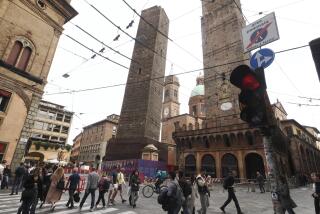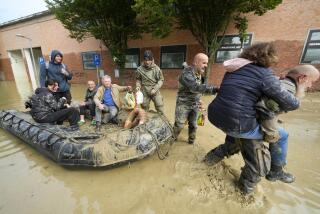Building Collapses in Italy; 50 Feared Dead
- Share via
ROME — A six-story apartment building, creaking from apparent structural flaws, collapsed before dawn Thursday as a few alert residents frantically tried to waken their neighbors.
Police said more than 50 people were feared dead under tons of bricks and concrete in the southern city of Foggia.
The disaster, the second of its kind in Italy in less than a year and the country’s worst in four decades, was expected to add momentum to a public outcry for periodic safety inspections of residential buildings. Italy requires inspections at the end of construction, but only in Rome are they mandatory after a building is occupied.
Italians awoke to nationally televised images of emergency workers and volunteers picking through the rubble with shovels and their bare hands. The rescue effort kept viewers captivated all day, prompted a minute of silence in the Italian Senate and brought Prime Minister Massimo D’Alema to the scene, 200 miles southeast of Rome.
By evening, 13 bodies had been pulled from the flattened remains of their homes. Of the 70 to 75 people who had been in the building, 17 were known to have survived the 3:15 a.m. collapse, police said.
The last survivor pulled out was a 25-year-old man named Piero, whose faint cries for help from deep in the ruins had spurred rescuers for more than nine hours. A 1-year-old boy named Antonio was rescued earlier by an aunt, Nicola Crincoli, who told reporters, “As soon as I saw his little hand in the rubble, I started digging.”
The building’s superintendent, Luigi Laconta, told reporters that a family of five heard the building shaking itself to pieces and ran from apartment to apartment ringing doorbells and banging on doors. He said he called the fire department and followed the family out of the building, where they kept trying to alert people by buzzing all 24 apartments on the intercom.
“I took a step back, thinking I would see someone stick their head out of a window,” Laconta said. “Instead, I saw the entire building crumple in front of me.”
Fire officials said the building collapsed within three minutes of the superintendent’s call.
“I heard my bed shake, like an earthquake,” Salvatore Taronna, 19, told reporters from his hospital bed. “Then I heard creaking noises, but I couldn’t understand what was happening. All of a sudden, I found myself deep in chunks of concrete.”
Many died in their sleep or on stairways as they tried to escape, survivors said.
“This is a true tragedy involving young families that has brought the city to its knees,” said Msgr. Domenico Ambrosio, the Roman Catholic archbishop of Foggia. “Man is powerless in the face of it. All we can do is show solidarity with the victims.”
Other Italians, however, demanded answers. The local prosecutor opened a criminal investigation into possible negligence in the building’s construction and maintenance. Foggia’s mayor, Paolo Agostinacchio, said a “structural collapse” was the “strongest hypothesis.” Fire officials said they had no evidence of an explosion.
Aldo Guidone told Italy’s ANSA news agency that his son Mario, who survived the collapse, had complained to the superintendent recently about a support column that was cracked and missing some of its internal rods. The mayor said he was unaware of the complaint.
ANSA reported that the contractor who built the apartment block between 1968 and 1971 lived there and was believed buried in the rubble.
Many buildings put up in the 1950s, ‘60s and ‘70s, as Italy’s postwar recovery gained momentum, were subject to building standards far more lax than those in force before or since, Italian architects say. Franco Barberi, Italy’s undersecretary for civil protection, said Thursday that structural problems with buildings have “become a recurring and alarming phenomenon.”
More than 2,000 Romans have demanded city inspection of their apartment buildings since Dec. 16, when 27 people died in the collapse of an apartment complex built here during the 1950s.
The outcry prompted Rome’s City Council to pass a law last week requiring buildings to be inspected every eight years. A similar bill approved this month by the Cabinet but not yet sent to Parliament would require inspections throughout Italy every 10 years. Backers of those measures said Thursday’s disaster will help accelerate efforts to put them into practice.
“Just as the citizen has understood that giving his car an annual checkup is fundamental for the safety of his life and that of others, we’re beginning to understand that our homes should get the same kind of inspection,” said Sergio Polese, president of Italy’s National Council of Engineers.
More to Read
Sign up for Essential California
The most important California stories and recommendations in your inbox every morning.
You may occasionally receive promotional content from the Los Angeles Times.













